We have two predominant lizard species here at Curbstone Valley, California (Southern) Alligator Lizards, and Coast Range (Western) Fence Lizards.
The Southern, or California Alligator Lizard (Elgaria multicarinata multicarinata) is the less common of the two species observed here, but still sighted relatively frequently during the warmer months.
This subspecies is endemic to California, ranging along the coast from Humbolt to Ventura county, and extending inland in the northern part of the range. They are found in grasslands, open forests and chaparral.
Alligator lizards have slender grey-brown colored bodies, ranging from 7-18 cm in length, with large heads and powerful jaws, with which they can inflict a nasty, and painful bite. Their limbs are short, but alligator lizards have long tails, sometimes as much as twice the body length. As with most lizards, they may detach their tail deliberately (caudal autonomy) as a defensive tactic. The tail will grow back, although generally not as perfectly as the original, and this is not without consequence. Tail regeneration is energetically expensive, and during regeneration, reproductive fitness and survival have been shown to be decreased.
Alligator lizards will hibernate in underground dens during cold winter months, emerging in early spring. Mating is thought to generally occur between April and May. Unlike some lizard species that engage in elaborate mating displays, alligator lizard males are more succinct. They simply pursue a female of interest, and mating ensues. As you can see below, I accidentally disturbed a mating pair this weekend seeking some privacy in one of our woodpiles.
We did apologize for the intrusion after capturing these photographs, covered them back up, and left them alone, as we’d love to see more of this species here on the property. This species is believed to lay eggs between May and July, with eggs hatching in late summer to early fall.
The diet of alligator lizards includes various invertebrate species, and occasionally young small mammals and birds.
On the farm, alligator lizards are also prey. I caught sight recently of this red-shouldered hawk (Buteo lineatus) outside the office window with the remains of an alligator lizard.
Just like snakes, alligator lizards shed their skin. As you can see below from another exciting wood pile find, they shed their skin in a single intact piece by essentially turning it inside out as they crawl out of it.
Proteins in the blood of both Southern Alligator and Western Fence Lizards have been shown to have a bactericidal effect on Borrelia burgdorferi, the causative agent of Lyme borreliosis (Lyme disease)[1]. As you can see from the pictures of the head of this male alligator lizard, we have no shortage of ticks, especially Western black-legged ticks (Ixodes pacificus), on this property during the spring months.
It has been shown that there is a lower proportion of adult Lyme-infected Ixodes pacificus than nymphal stage ticks in regions where these lizard species reside, and this is thought to be a result of the adult ticks feeding on these lizard species as nymphs[2].
Lyme bacteria reside in the gut of nymph-stage ticks, and the bacteria are believed to then be destroyed in the gut when the ticks feed on the blood of the lizards. This may help to account for a relatively lower incidence of Lyme disease in humans in regions where alligator and fence lizards are endemic. Just one of many reasons these lizards are valued residents of the farm.
———————————
We leave all wild animal species at Curbstone Valley in their natural environments, and are careful not to damage sensitive habitat and hiding places. Note that it is illegal to collect and possess native reptile species in California without the required licenses and/or permits.
[1] Kuo MM, Lane RS, Giclas PC. A comparative study of mammalian and reptilian alternative pathway of complement-mediated killing of the Lyme disease spirochete (Borrelia burgdorferi). J Parasitol. 2000 Dec; 86(6):1223-8
[2] Lane RS, Mun J, Eisen L, Eisen RJ. Refractoriness of the western fence lizard (Sceloporus occidentalis) to the Lyme disease group spirochete Borrelia bissettii. J Parasitol. 2006 Aug; 92(4):691-6.

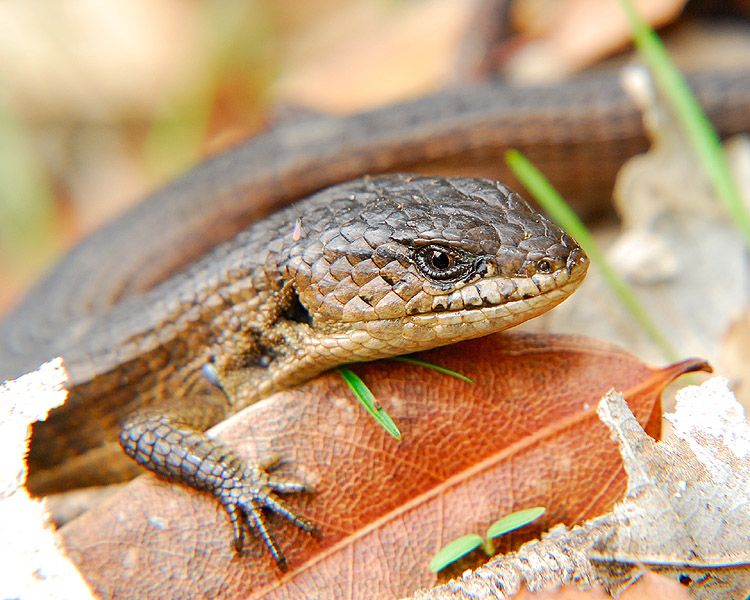

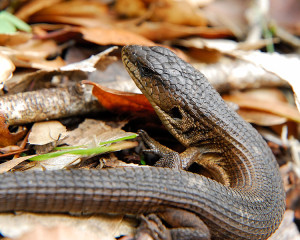
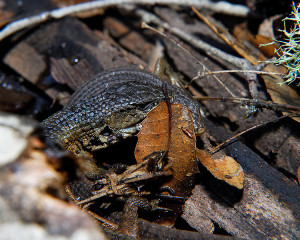
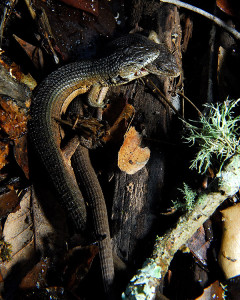
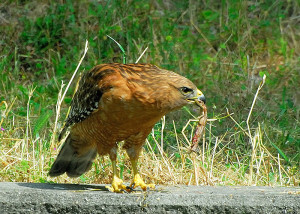
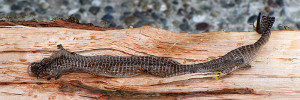

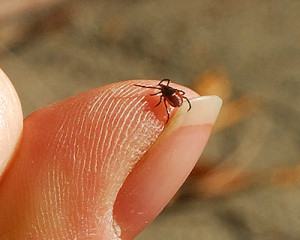







This is the 2nd one of these I’ve seen on blogs today. I didn’t realise that they looked like snakes – I thought they had legs as in the other post about them it was a photography shot of them. What fascinating info about the ticks and lyme disease and how those little lizards help stop that disease in its tracks as its such a terrible disease.
Dear CV, I think it is so good that you go to the trouble of highlighting some of the native flora and fauna of your area and it is always interesting to learn what is to be found where.
The lizards, such as you show, I would find a little difficult to live with, particularly if they were to come inside the house.
Great reptile identification!
How in the heck do you get those photos? They are fantastic. I can’t get the lizards here to stop zipping around. Saw my first of the season today – they are wonderful creatures, aren’t they? Thanks for pointing out their benefits.
Great captures. Love the photos.
Sometimes doing the chores can really be rewarding. Not sure I’d appreciate the startle effect finding them that way but I’d still love to find something other than stashes of basswood seeds left by some mouse in my firewood.
I’m happy north of nowhere. I think the cold prevents our snakes from growing legs.
How funny Rosie, it must be Alligator Lizard day!
Edith, we’ve found a couple of these lizards in the house, though I can’t fathom how they managed to get in. They don’t bother me nearly as much as finding scorpions in the house though! I am always concerned when I find one indoors, as they may have gone for quite sometime without food and water. We’re always quick to find a good spot out in the garden for them though.
Karyl, for the photos, not sure if it’s luck, or if I cheat. I suppose I cheated somewhat…though I also try not to leave the house without my camera. The first two photos were of an alligator lizard that ventured out on a rather cold day, and wasn’t moving very fast. The other photos with the mating pair…well…clearly they were preoccupied 😛 I need to learn to go outside with a video camera though…it’s difficult to capture behaviors with still images!
Cute little buggers! I love the info on lyme disease – we’ve got our fair share here in PA, including a case right in my own house last spring. Fortunately, it showed up as a bulls-eye on my daughter’s leg so we caught it early. Thanks for informing!
This was so interesting. I’ve never seen or heard of one of these. My 11 year old daughter would be fascinated to find something like this outside.
I always learn so much when visiting your blog Clare! Wonderful photos and narrative! Fascinating about the ticks. How lucky to find the mating pair! For you and us! I thought of you today when I bought a bottle of Paul Stamets fungi immune booster. ;>)
Makes me think of the ever-popular ‘lizard earrings’.
Probably, this should not be done with alligator lizards, however.
Best,
Veratrine
Lizard porn! Clare, shouldn’t you put a “18 or older only” label on this post?! Kidding… Enviable shots and an interesting bit about Lyme disease. Also, thanks for including the reminder about illegally collecting them- very important!
Hurrah for California’s lizards! I was so delighted when I saw Western Fence Lizards in the garden that I carved out of a trash strewn lot in West Oakland.
I just want to thank you for all the research you put into these posts about the native denizens of curstone valley. It’s always a fascinating read. The information about the ticks and the anti lyme disease properties of this lizards’ blood was fascinating. All the more reason to have our native wildlife and plants intact.
That should read curbstone of course.
Lovely and interesting post! I wasn’t surprised to see the photo of the skin in the wood pile as these creatures resemble snakes at a glance. I applaud your efforts to encourage the native wildlife. Additionally, nice info re. the lyme disease and ticks.
Holy moly what an amazing moment you caught! Wonderful photo of that “love bite” – wow! That made my day! Most wonderful blog! In a world of hyperbolic comments, let me be the hyperbolicest! BTW I also just noticed your weather and moon widgets and will be sure to drop in to take advantage of that feature – thanks so much! I wonder if the alligator lizard I disturbed in our to-be-burned wood pile has found another place to lodge; I sure hope so. I don’t think I left enough wood there to keep him happy.
I am so glad you leave habitat for these beautiful reptiles on your property. I also love the details that you observe and how you get those action photos. Great info. Well done!
Oh my, so interesting! Thank you for this amazing info and fabulous photos.
Really nice article about those guys. Many people shrink back in horror at mere mention of the A-Lizards and really they are so valuable. I think your article changed a few minds! I will never forget being bitten by one, that is for sure. Look but don’t touch! As a former CA native now transplanted to the Pacific NW, your blog really brings back sweet memories for me, Great photos! A bookmarker! Cherrs, Bonnie
Great post and photos of Alligator Lizards. We have them in our urban yard in southern California, which is also a certified NWF wildlife habitat. The lizards like our small pond in the front yard, but sometimes they venture into our house. We shoo them back out as best we can. We don’t try to pick them up though. They’re nasty little buggers and will bite.
What an informative post! It’s great that you try to keep their habitats for them. It’s also good that you have pointed out the benefits regarding Lyme disease.
An interesting and informative post. As the mother of three boys, I have learned to love lizards and skinks. Our most common lizard is the little green anole, who is a real charmer compared to your guys!